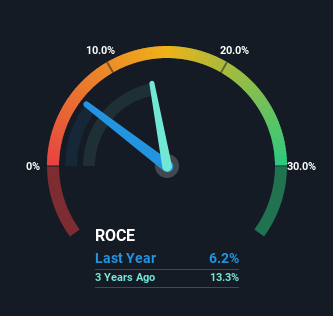[ad_1]
If we want to find a potential multi-bagger, often there are underlying trends that can provide clues. Ideally, a business will show two trends; firstly a growing return on capital employed (ROCE) and secondly, an increasing amount of capital employed. This shows us that it’s a compounding machine, able to continually reinvest its earnings back into the business and generate higher returns. However, after investigating Himatsingka Seide (NSE:HIMATSEIDE), we don’t think it’s current trends fit the mold of a multi-bagger.
Understanding Return On Capital Employed (ROCE)
Just to clarify if you’re unsure, ROCE is a metric for evaluating how much pre-tax income (in percentage terms) a company earns on the capital invested in its business. To calculate this metric for Himatsingka Seide, this is the formula:
Return on Capital Employed = Earnings Before Interest and Tax (EBIT) ÷ (Total Assets – Current Liabilities)
0.062 = ₹2.2b ÷ (₹56b – ₹21b) (Based on the trailing twelve months to June 2022).
Thus, Himatsingka Seide has an ROCE of 6.2%. Ultimately, that’s a low return and it under-performs the Luxury industry average of 14%.
Check out the opportunities and risks within the IN Luxury industry.

Above you can see how the current ROCE for Himatsingka Seide compares to its prior returns on capital, but there’s only so much you can tell from the past. If you’d like to see what analysts are forecasting going forward, you should check out our free report for Himatsingka Seide.
How Are Returns Trending?
When we looked at the ROCE trend at Himatsingka Seide, we didn’t gain much confidence. To be more specific, ROCE has fallen from 18% over the last five years. Meanwhile, the business is utilizing more capital but this hasn’t moved the needle much in terms of sales in the past 12 months, so this could reflect longer term investments. It may take some time before the company starts to see any change in earnings from these investments.
The Key Takeaway
Bringing it all together, while we’re somewhat encouraged by Himatsingka Seide’s reinvestment in its own business, we’re aware that returns are shrinking. And investors may be expecting the fundamentals to get a lot worse because the stock has crashed 70% over the last five years. Therefore based on the analysis done in this article, we don’t think Himatsingka Seide has the makings of a multi-bagger.
On a final note, we found 4 warning signs for Himatsingka Seide (1 is significant) you should be aware of.
For those who like to invest in solid companies, check out this free list of companies with solid balance sheets and high returns on equity.
Valuation is complex, but we’re helping make it simple.
Find out whether Himatsingka Seide is potentially over or undervalued by checking out our comprehensive analysis, which includes fair value estimates, risks and warnings, dividends, insider transactions and financial health.
View the Free Analysis
Have feedback on this article? Concerned about the content? Get in touch with us directly. Alternatively, email editorial-team (at) simplywallst.com.
This article by Simply Wall St is general in nature. We provide commentary based on historical data and analyst forecasts only using an unbiased methodology and our articles are not intended to be financial advice. It does not constitute a recommendation to buy or sell any stock, and does not take account of your objectives, or your financial situation. We aim to bring you long-term focused analysis driven by fundamental data. Note that our analysis may not factor in the latest price-sensitive company announcements or qualitative material. Simply Wall St has no position in any stocks mentioned.
[ad_2]
Source link








